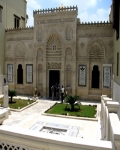- Latest Archaeology Updates
- Importance and applicability
- Famous Archaeologists
- Museums Collections
- Site Map
- World Heritage Sites
- World History Monuments
- Archaeological Organizations
- World Atlas of Archaeology
- Forensic Investigation and Geophysics
- Contact Us
- Movies based on Archaeology
- Frequently Asked Questions
- Archaeological discoveries
- Tell a Friend
- Archaeological Abbreviations
- Gallery Collections
- Famous-Museums site map
- Famous-archaeologists site map
- Archaeological Monuments site map
The Coptic Museum is an Egyptian museum located in Cairo and dedicated to Coptic culture and art. It was founded in 1908 by Marcus Simaika Pasha and houses the worlds largest collection of Coptic art and artifacts. It occupies a large hall in the Old Cairo district, near the Coptic Orthodox Cathedral of Saint Mark, and is one of the few museums in Egypt that are devoted to a specific religious group.
The museum is divided into twelve sections, each of which houses a unique collection of artifacts. The sections include the Pre-Christian Egyptian and Roman Periods, the Early Christian Period, the Islamic Period, and the Late Coptic Period. Each section contains various artifacts such as coins, jewelry, carved stones, pottery, and textiles. The museum also contains a library that is dedicated to Coptic studies, which houses a vast collection of books and manuscripts. The Pre-Christian Egyptian and Roman Periods are represented by a number of artifacts that reflect the lifestyle of the ancient Egyptians. These include jewelry, pottery, and coins. The Early Christian Period is represented by artifacts such as icons, liturgical books, and manuscripts. The Islamic Period is represented by artifacts such as coins, pottery, and textiles. The Late Coptic Period is represented by artifacts such as manuscripts and textiles. The museum also houses an extensive collection of Coptic art and artifacts. These include a number of statues, paintings, and frescoes. The most famous of these is the statue of Saint Mark the Evangelist, which is believed to have been sculpted by the Coptic artist, Apollonius. Other notable works of art include a number of icons, frescoes, and paintings depicting biblical scenes. The museum also contains a large number of manuscripts and books. These are mostly written in Coptic and include works of literature, philosophy, and theology. The most significant of these is the Codex Sinaiticus, which is one of the most important manuscripts in the world. The Coptic Museum is an important center for the study of Coptic culture and art. It is a place where one can learn about the history and heritage of the Copts. The museum is open to the public and is free of charge. The museum also hosts various exhibitions and conferences throughout the year, which are aimed at promoting knowledge about Coptic culture and art. It is an excellent resource for those interested in learning more about the Coptic culture and art.

